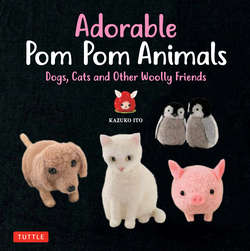Читать книгу Adorable Pom Pom Animals - Kazuko Ito - Страница 5
На сайте Литреса книга снята с продажи.
ОглавлениеTools | Basic tools used in this book
1. Cardboard
For making ears and mini pom poms. Also useful for felting small amounts of wool roving since the cardboard prevents accidental stabbing of fingers.
2. Felting Needle Mat
Place this mat beneath the wool roving to use felting needles.
3. Fabric or Craft Glue
Dab to secure knots when attaching strings or to adhere eyes, ears and legs to pom poms.
4. Crochet Hook
Use to connect pom poms together. With larger pom poms, a yarn darning needle may not be long enough so a crochet hook is handy to have.
5. Yarn Darning Needle
For connecting ears to the head and such. Select a needle with an eye that will accommodate the thickest string or yarn you will be using.
6. Pins
To indicate eyes and nose positions or to mark the crown of the head when trimming the pom pom.
7. Felting Needle
For felting wool roving. Also used to attach ears, nose and legs to pom poms (we will refer to it as simply “needle” in this book).
8. Bamboo Stick
Helpful for adding small drops of glue to beads and string knots.
9. Clips
Secure various sections with clips while felt pieces are drying once glue has been applied to form shapes. Clothespins work as well. Small sizes are recommended.
10. Scissors
Try to use scissors with extra sharp tips. It should fit comfortably in your hand.
11. Round Nose Pliers
Pliers with rounded tips. Use to bend wires.
12. Wire Cutter
For cutting wire and to trim eyes and nose parts that may be too long.
13. Tweezers
To arrange and adjust pom pom yarn during construction. It’s also helpful for picking up small parts such as beads and eyes.
14. String or Twine
Use to tie the center of the pom pom. We recommend kite string.
15. Heavy Duty Sewing Thread
For tying the center of mini-pom poms or to create the mouth for some of the animals.
Pom Pom Sizing
Below are the different sizes of pom pom makers and the corresponding pom poms for reference. Pom pom density will vary depending on the thickness of the yarn and the number of times the yarn is wound; some will be thick and solid, while others may be fluffier and soft.
※The two arms are combined and the yarn is wound on each half. Instructions will indicate which side to wind first with A. B will be wound next.
※The pom pom maker used for the projects in these books was Hamanaka Kuru Kuru Pom Pom Maker, a Japanese brand. Many different brands are available, such as Clover, Lion and others. Sizes, design and instructions for use vary from brand to brand, so it’s a good idea to visit craft shops for a good look, and check out YouTube videos to see how they’re used. Buying a set is a good idea too, so that the different sizes will be in proportion with one another.
Tips
Other than the 1⅜ in (3.5 cm) pom pom maker size, winding the yarn tightly will result in an elliptical shape instead of a circle. This shape can be used in a variety of ways such as the animal body.
Yarns
Select the appropriate yarns. The photo below is a guide to the weights that are most commonly used in these projects. If you prefer a different yarn, or the recommended types aren’t available to you, adjust for differing weight by increasing the number of windings for thinner yarn and vice versa.
Taking up the yarn ends To wind two strands at once, take one strand from the outer part of the yarn ball or skein, and another strand from the inside; if you insert your fingers into the center of the ball, you should find a clump of yarn that can be pulled out.
Other Materials
Supplies needed in addition to yarn for project construction. For felt and wool roving, try to find similar materials.
1. Felt
Used for the hamster and cat ears, the penguin’s beak, etc. A thin layer of craft glue is applied on both sides of the felt. Once the glue is dry, cutting out small pieces is a snap.
2. Wool Roving
Ears, nose, legs are formed by felting wool roving with a special felting needle on top of a felting needle mat.
※ We use the “Flufeel” brand roving in this book.
3. Embroidery Floss Size 25
Create the chick’s legs by wrapping the embroidery floss around a piece of wire.
4. Pipe Cleaner
By wrapping wool roving around the pipe cleaner and using a needle to felt it, the elephant’s nose and cat’s tail can be shaped.
5. Wire
For the chick’s leg and fried shrimp.
Eyes • Noses Parts
The eyes and nose pieces are essential in creating facial expressions. We’ve listed a variety of sizes, shapes and colors of plastic safety eyes and noses below. Slight modifications to the eye placement can completely alter the expression, so play around with different arrangements (see p. 54).
